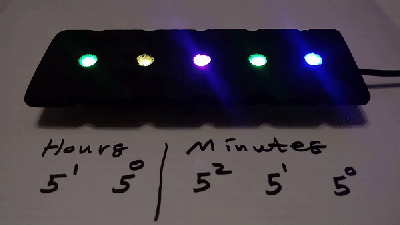If binary digits are bits, are quinary digits “quits”? Perhaps, but whatever you call them, you’re going to have to wrap your head around some new concepts in order to make sense of this quinary display clock.

Why quinary? [Spike Snell] wanted to minimize the number of LEDs, and 52 is enough to cover all 24 hours. Binary clocks may have geek chic, but there are only so many ways to display ones and zeros.
[Spike]’s clock is unique because it shows each quit using a single WS2812 Neopixel. The values zero through four are each represented by a different color, meaning the user needs to memorize which color goes with which value, which we suspect is the hardest part of learning this clock. The clock’s software is fairly simple and runs on an ESP8266, and uses NTP to keep on track. The clock self-adjusts for Daylight Savings time, and it has a nice feature that dims the display in the evening to make living with it easier.
Even for those not up on their base-five arithmetic, [Spike]’s clock is still a nice, slowly evolving abstract art piece. And for those who grok the quinary clock, perhaps a career awaits you in an alternate future where bi-quinary relay computers caught on.
















Shouldn’t it be easy to do quinary in my head since base 5 is a multiple we use all the time? Steam starts coming out of my ears when I realize that decimal 10 is quinary 20.
Ah, now I’ve got it… Saying the number “twenty” in my head breaks my ability to think in quinary. But if I say “two-zero” that’s easy to equate with decimal ten. So “one-zero” is 5, “two-zero” is 10, “three-zero” is 15. Multiply by five and you gain a digit… “one-zero-zero” is 25, “two-zero-zero” is 50. Neat!
I have a similar problem, whenever I add 7 + 7, then I have to remember the base I’m working in to determine if the answer is 14, 16 or E.
Hmmm. Use the resistor color code for an easy way to associate a color with a number.
Good luck with number 1 (brown color) with neopixels
Thanks again for the great write-up!
I’ve put the code for this onto github for anyone that wants to build one of these: https://github.com/Crysknife007/quinary-led-clock
Seems like the minimum number of neopixels you need for a clock would be one. Just assign 60 colours to the minutes of a clock face based on a colour wheel. That’s your hour hand position.
Well this will save me a lot of work. I had a similar idea, but I used base 4 and 4 neopixels, giving the time but not the date. I used the color scheme blue (for zero) then green-yellow-red like a traffic light for 1-2-3. I was even going to use an ESP8266 to power it, and I hand milled four nice little enclosures. (A white polyethylene tubing plug, available from Lowe’s parts drawers, makes a great diffuser. In mockup I found the undiffused neopixels very annoying to read.) Then I got bogged down with other stuff, but the changes to Dan’s code to finish implementing my scheme will be trivial.
Neat!
Only have to remember 4 colors as 0 could be ‘off’. ‘white’ would be max (4). Then your traffic light pattern for the other three. Doesn’t matter though as long as ‘you’ can remember it!
I thought “neopixel” was a brand name. Is Hackaday owned by that other company? Is this over-priced-product placement??
No.
Quite a fine shiny quine line!
Two words destroy this idea: Color Blind
There are 10 types of people in the world.
Those who understand binary,
Those who don’t,
Those who understand there are other bases you can use…
…and 2 more.